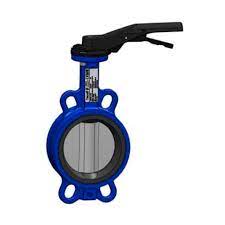The butterfly valve is an open or close 1/4 turn valve which also allows you to do regulation. Butterfly Valves are especially adapted for general uses and non-viscous industrial fluids.
Different types :
– Butterfly valve with sleeve
– Butterfly valve with flanges
– Double eccentric type butterfly valve with flanges
– High performance butterfly valve
– PTFE lined butterfly valve
– Air register valve
In the realm of industrial fluid control, butterfly valves have emerged as versatile and efficient devices. Combining simplicity, reliability, and adaptability, these valves are a crucial component in various industries. In this article, we will explore the characteristics, types, and applications of These valves.
Butterfly valves belong to the quarter-turn valve family, providing an efficient mechanism for regulating the flow of fluids. Unlike traditional gate valves, which operate through a linear motion, These valves work by rotating a disc or plate within the valve body. This rotation allows for quick and precise control over fluid flow. These valves are highly valued for their simplicity and ease of operation, making them suitable for a wide range of applications.
Characteristics and Advantages
The design of butterfly valves imparts several advantages, making them a preferred choice in fluid control systems:
- Quick Operation: These valves can be opened or closed with a quarter turn, enabling rapid response in applications that require timely flow adjustments.
- Regulation Capability: Beyond simple on/off functions, butterfly valves also offer throttling or regulation capabilities. This makes them valuable in systems where flow rates need to be adjusted.
- Compact Design: These valves are typically more compact than other valve types, requiring less space for installation. This design feature is particularly useful in applications with limited space.
- Cost-Effectiveness: The relatively straightforward construction of butterfly valves translates to cost savings in terms of both production and maintenance.
- Low Pressure Drop: When fully open, These valves have minimal obstruction to the flow path, resulting in lower pressure drop across the valve compared to other designs.
Types of Butterfly Valves
- Butterfly Valve with Sleeve: This type of valve features a flexible sleeve or liner that ensures a tight seal. It is commonly used in applications where leak-tightness is critical.
- Butterfly Valve with Flanges: These valves come with flanged ends for easy installation and secure connection to the pipeline.
- Double Eccentric Type Butterfly Valve with Flanges: This design incorporates a double-offset shaft, reducing wear and friction during operation. It is suitable for applications with high-pressure and temperature conditions.
- High-Performance Butterfly Valve: Engineered for demanding applications, these valves offer enhanced durability, reliability, and precision control.
- PTFE Lined Butterfly Valve: The use of PTFE lining provides exceptional resistance to corrosive and aggressive fluids, making it ideal for industries handling such substances.
- Air Register Valve: These specialized These valves are used in heating, ventilation, and air conditioning (HVAC) systems to regulate airflow and temperature.
Applications
Butterfly valves find applications in a diverse range of industries:
- Water and Wastewater Treatment: These valves are used for controlling the flow of water, chemicals, and slurry in treatment plants.
- Chemical Industry: These valves are suitable for managing the flow of various chemicals, acids, and corrosive liquids.
- Oil and Gas: In pipelines and processing plants, These valves play a role in fluid and gas control.
- Food and Beverage: They are employed in food processing and beverage production for their sanitary design and efficient operation.
- HVAC Systems: Air register valves help regulate airflow in heating and cooling systems, ensuring optimal indoor comfort.
In conclusion, butterfly valves stand as a testament to engineering ingenuity, offering a pragmatic solution for fluid control across industries. With their array of types and applications, these valves continue to be indispensable components in modern industrial processes. Whether for open/close or regulation tasks, butterfly valves contribute to efficient and effective fluid management.
